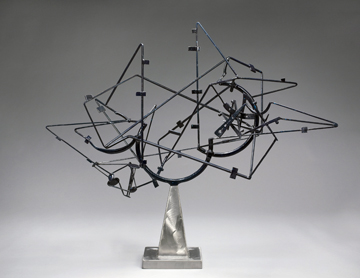Art Review: In Focus- David Smith's Star Cage (1950)
By Ina Cole
October 1, 2016
In the 1950s David Smith became a leading figure in the development of welded steel sculpture, which constituted a key direction taken by American artists after the Second World War. Smith’s previous experience of working on the construction of cars and locomotives gave him knowledge of the infinite possibilities of this material. Star Cage, therefore, offers a potent dichotomy in the way it flows effortlessly and organically, yet is constructed of industrial material used to support or embellish almost every public structure.
Star Cage is an important work of this period: it is one of a number of sculptures utilising a linear arrangement of forms that have the capacity to activate open space. The work takes the form of a latticed cage constructed of sharply manipulated steel rods, dynamically angled and notched at key intersections to suggest the distant glimmer of starlight. These astral clusters are mysterious entities, which act as bonds of tension that imbue the work a spectacular frisson. In its predilection towards improvisation and the fantastical, Star Cage retains the Surrealist overtones that had occupied so many artists in the preceding decades.
The interconnected rods used in Star Cage are arranged as vertical and horizontal planes, prompting the viewer to gaze through the work and not just at it. Star Cage does not offer a dominant view, but a shifting sequence of possibilities when viewed from the back, front and sides. It is both ambiguous and pictorial, like an abstract drawing in space with no fixed point. The act of looking, therefore, becomes a process of discerning fragments that appear to expand and contract as the viewer examines the work in the round.
Star Cage radiates out from the narrowest tip of a quasi-industrial cone, which acts as its support. This creates a precarious balance, rendering the work aesthetically weightless as it seemingly hovers in mid-air. Sculpture had originally gained power from solidity and mass, but Star Cage exerts its force by the use of a skeletal structure that challenges the historical canon. Stars, as seen in the night sky, are arranged in a flattened system with a well-defined central nucleus, and Smith’s choice of material and method in Star Cage perfectly captures the complexity of these awe-inspiring constellations.
Star Cage is in the collection of the Frederick R. Weisman Museum, University of Minnesota, Minneapolis. It is loaned to Royal Academy of Arts, London for the exhibition ‘Abstract Expressionism’ to 2 January 2017, which tours to Guggenheim Museum Bilbao from 3 February to 4 June 2017. David Smith’s work can also be seen in ‘The Looser Collection: Dialogues’, Museum Folkwang, Essen to 30 October 2016; and ‘Modern Sculptors in Indiana’, Eskenazi Museum of Art, Indiana University to 12 March 2017.
November’s ‘In Focus’ is Arshile Gorky’s Water of the Flowery Mill (1944)

